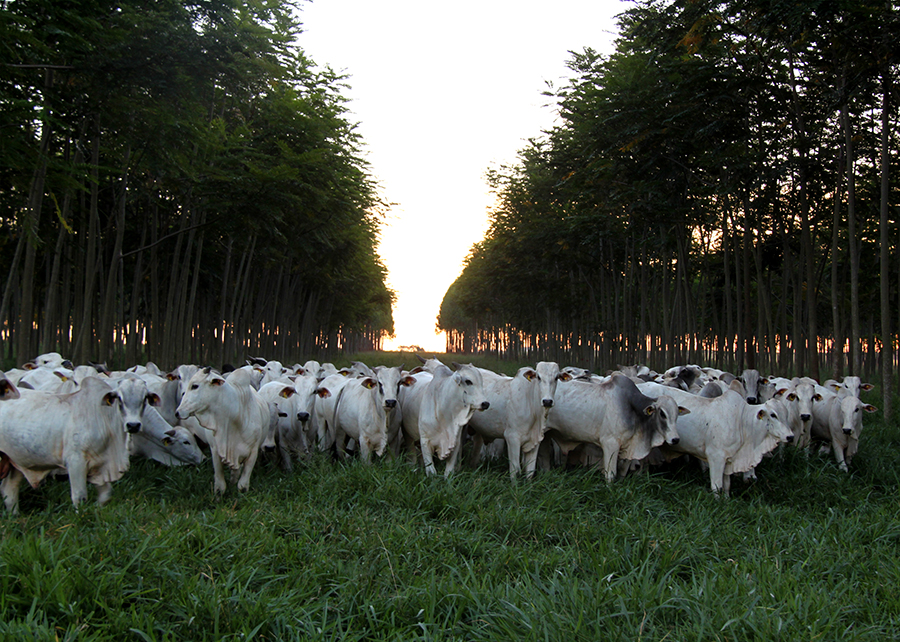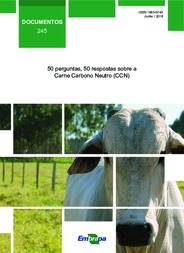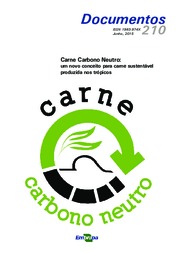Certification identifies beef produced in systems that neutralize greenhouse gas emissions. Carbon Neutral Brazilian Beef gives the producer a competitive edge and opens doors to demanding international markets. The protocol includes environmental concerns, animal welfare, good practices and legal compliance. Carbon Neutral Beef Seal also provides product traceability and attests producer social responsibility. Embrapa researchers have developed a protocol for farmers interested in producing beef mitigating the impacts caused by greenhouse gas (GHG) emissions. Livestock is considered a source of the emission of these gases, especially because of the methane gas generated in the digestion process of ruminants. However, it is possible to offset GHG emissions by integrating production with planting trees and adequate pastures management, for example. Scientists at Embrapa Beef Cattle (in Mato Grosso do Sul state) developed guidelines to offset emissions generated in the field. They based it on experiments that measured and estimated carbon-equivalent emissions and absorption in livestock. The result was the Carbon Neutral Brazilian Beef (CNBB) protocol, which is based on integrated crop-livestock-forest system, or silvopasture. The property can claim the use of the CNBB Seal for an independent certifier, which will evaluate and approve the area. “CNBB is based on this protocol. It is a set of standards that must be followed by producers and attested by an Embrapa certifier,” says the Embrapa researcher Fabiana Villa Alves. Trees integrated into the production system are one of the requirements of the protocol (see box). The producer can choose to integrate livestock system both with forest or crop (integrated crop-livestock-forest system). Trees are essential Researchers explain that trees have a crucial role in the production system. Trunks remove carbon from the atmosphere and store it. This process balances and neutralizes carbon emissions. It is possible to estimate the fixed amount of carbon, considering the volume of wood produced by the trees, based on equations that use their height and diameter at breast height. In long-term experiments, researchers concluded that from 200 to 400 trees per hectare to neutralize methane emissions from one to three adult cattle per year is ideal, considering that generally only half of these trees are for the production of sawn wood, which is what effectively accounts for the neutralization calculation according to the CNBB protocol. Planted trees also have other advantages. Besides recomposing the rural landscape, they also contribute to animal welfare. They create a milder temperature microclimate, provided by the abundant shade area. In addition, they diversify the income of the producer. As a long-term investment, the farmer will also profit by selling the wood, providing more financial security to the activity. “If the integration is well done, the profitability will become very interesting”, the forest engineer Moacir Reis attests. He is the director of the Boa Aguada farm of the Mutum group and president of the Sul-Mato-Grossense Association of Producers and Consumers of Planted Forests (Reflore MS). According to Reis, working with a single product may be an economic risk, which can be reduced by income diversification. Embrapa developed SisILPF software to help producers to manage planted trees in integrated systems. SisILPF simulates the performance of plantations and ways of managing trees in integrated systems, according to the producer's goals. The software provides support for precision handling, economic analysis and forest component planning. It is available for the main species of pine and eucalyptus. The researcher stresses that the certification is not for the whole farm, but for the CNBB production area. There must necessarily be either an integrated crop-livestock-forest or an integrated crop-livestock system. To start implanting the system in a pasture area, the animals must be placed there only when the trees are at least 6 cm in diameter. This ensures that the animals in the system will not damage the trees, in order to not reduce the commercial value of the wood that will be produced. The continuous annual forest inventory is also required for monitoring carbon sequestration. It is also mandatory to record the carbon content in the soil, through biannual sampling. These values cannot decrease over time. Invasive plants in the pasture area must be controlled, and the producer must replace the soil nutrients. If there is a surplus of pasture, other animals can graze in the CNBB area as long as the maximum capacity is respected and the animals are properly identified. Animals from the CNBB Program should not graze in non-certified areas. The herd record must be controlled and presented, including the number of animals in the area, with dates of entry and exit, in addition to the number of deaths. The use of agricultural, nutritional and veterinary inputs as well as zootechnical control must be registered in the same way. It is mandatory to control the exit of animals to any other area. A list with the individual identification of the animals and all their movements must be sent to the certifier. For certification purposes, male (both intact and castrated) and female animals are accepted. All must be traceable and visually different from other animals in the herd. The program recommends the use of an alternative marking to fire marking and completely prevents mutilation. Beyond emissions The CNBB protocol is not restricted to environmental care; it also covers several other areas, such as food safety. Animal health management procedures are required, in addition to mechanisms that allow product traceability along the chain. The herd immunization schedule must be strictly followed, according to the region and state the farm is located. Vaccines must be registered and the application must be made on the “neck region”, the correct place according to the experts. The animal with an abscess after vaccination shall be disqualified. The indication of the application site is also valid for vermifuge and other injectable medications. All therapeutics used in the animals of the CNBB program must be registered in a specific book and will be inspected by the certifier. Production must be totally in accordance with the Brazilian Forest Code (Law 12,651/2012 – Lei nº 12.651/2012) and be under the Rural Environmental Registry (CAR). The seal is granted only to properties that present social responsibility. It is necessary to prove that the labor legislation is being followed. The certification verifies if employees are duly remunerated, have good housing, hygiene, food and work conditions, such as the provision of personal protective equipment, for example. Quality livestock feed Pasture must be the main source of food for animals, although they must be supplemented all year round. Supplementation should not exceed the rate of 2% of live weight. Supplementation in “pasture-based and confined feeding hybrid system” is allowed for up to 105 days. The animals must drink good quality current flow water or, if not possible, frequently renewed quality water. In grazing management, the species must be those indicated for the region both soil and climate conditions. Enough quantity of quality food must be guaranteed for the animals through management techniques. The protocol emphasizes that special attention should be given to the implantation and management of forage. Its inadequate management can cause pasture degradation, which makes the concession of the seal unfeasible. Therefore, the minimum grazing heights according to the species and cultivar used must be respected. Embrapa has tools that assist the producer in this task, such as the régua de manejo de pastagem. 100% Brazilian product “CNBB is a genuinely Brazilian technology. We did not go after solutions from abroad, the opposite: we are today a reference for specialists who come from other countries to get to know our technology,” Fabiana Villa proudly states, emphasizing that Brazilian work has been supporting GHG mitigation programs in livestock in other countries, for instance Australia and Argentina. CNBB is more than a technology: it is a brand concept capable of transforming the animal protein production nationally and internationally. This is the opinion of the Embrapa researcher, Cleber Oliveira Soares, current director of the Department of Support to Agricultural Innovation at the Ministry of Agriculture, Livestock and Supply (Mapa). “The CNBB concept will contribute not only to the sustainable animal protein production in Brazil and in the tropics, but also to productive and environmental gains in the short, medium and long terms,” Soares predicts. “The advantage of CNBB certification is that it does not exclude other certifications, and can be added to specific breed seals. In the case of cattle, other brand concepts, with the same logic as CNBB, are being created, such as the Carbon Neutral Calf and Carbon Neutral Leather, within what Embrapa called the Certified Low Carbon Livestock Platform. The trend is to consolidate this movement in other production chains,” Villa believes. Market for Carbon Neutral Brazilian Beef Beef market exports13.2 million tons annually. Brazil alone exported 2.2 million tons in 2019. The market for special meat such as CNBB is promising, as is the growing number of consumers who demand products quality and sustainability. Refrigeration companies have been interested and have followed the evolution of CNBB production. On August 27, Marfrig launched a special product line with Viva to differ meat produced under the CNBB certification. Embrapa Beef Cattle researcher Roberto Giolo believes that Brazilian beef will benefit from the CNBB seal. It may also reach more demanding markets, both domestic and foreign, with the potential to increase Brazilian exports, which include costumers from European countries. Giolo believes that the seal will be a facilitator for the achievement of the national goals foreseen in the National Plan for Low Carbon Emission in Agriculture (Plano ABC), since it will encourage the adoption of integrated production systems. “The program is innovative and has great growth potential,” Fabian Perez Gonçalves bets. He works for SGS, a certification services company. Sergio Pimenta, from SBC certifier, said he was surprised by the technological and scientific basis of the CNBB protocol. “It is huge and I have never seen anything so detailed. There are many concepts, and the label will encourage producers to adopt the necessary technologies,” he says. SBC operates several protocols in Brazil and is the largest certifier of tracking animals for export. Translation: Ana Maranhão
Photo: iStock

It is possible to offset GHG emissions by integrating production with planting trees and adequate pastures management
-
Certification identifies beef produced in systems that neutralize greenhouse gas emissions. -
Carbon Neutral Brazilian Beef gives the producer a competitive edge and opens doors to demanding international markets. -
The protocol includes environmental concerns, animal welfare, good practices and legal compliance. -
Carbon Neutral Beef Seal also provides product traceability and attests producer social responsibility. |
Embrapa researchers have developed a protocol for farmers interested in producing beef mitigating the impacts caused by greenhouse gas (GHG) emissions. Livestock is considered a source of the emission of these gases, especially because of the methane gas generated in the digestion process of ruminants. However, it is possible to offset GHG emissions by integrating production with planting trees and adequate pastures management, for example.
Scientists at Embrapa Beef Cattle (in Mato Grosso do Sul state) developed guidelines to offset emissions generated in the field. They based it on experiments that measured and estimated carbon-equivalent emissions and absorption in livestock. The result was the Carbon Neutral Brazilian Beef (CNBB) protocol, which is based on integrated crop-livestock-forest system, or silvopasture. The property can claim the use of the CNBB Seal for an independent certifier, which will evaluate and approve the area. “CNBB is based on this protocol. It is a set of standards that must be followed by producers and attested by an Embrapa certifier,” says the Embrapa researcher Fabiana Villa Alves.
Trees integrated into the production system are one of the requirements of the protocol (see box). The producer can choose to integrate livestock system both with forest or crop (integrated crop-livestock-forest system).

Trees are essential Researchers explain that trees have a crucial role in the production system. Trunks remove carbon from the atmosphere and store it. This process balances and neutralizes carbon emissions. It is possible to estimate the fixed amount of carbon, considering the volume of wood produced by the trees, based on equations that use their height and diameter at breast height. In long-term experiments, researchers concluded that from 200 to 400 trees per hectare to neutralize methane emissions from one to three adult cattle per year is ideal, considering that generally only half of these trees are for the production of sawn wood, which is what effectively accounts for the neutralization calculation according to the CNBB protocol. Planted trees also have other advantages. Besides recomposing the rural landscape, they also contribute to animal welfare. They create a milder temperature microclimate, provided by the abundant shade area. In addition, they diversify the income of the producer. As a long-term investment, the farmer will also profit by selling the wood, providing more financial security to the activity. “If the integration is well done, the profitability will become very interesting”, the forest engineer Moacir Reis attests. He is the director of the Boa Aguada farm of the Mutum group and president of the Sul-Mato-Grossense Association of Producers and Consumers of Planted Forests (Reflore MS). According to Reis, working with a single product may be an economic risk, which can be reduced by income diversification. Embrapa developed SisILPF software to help producers to manage planted trees in integrated systems. SisILPF simulates the performance of plantations and ways of managing trees in integrated systems, according to the producer's goals. The software provides support for precision handling, economic analysis and forest component planning. It is available for the main species of pine and eucalyptus. |
 The researcher stresses that the certification is not for the whole farm, but for the CNBB production area. There must necessarily be either an integrated crop-livestock-forest or an integrated crop-livestock system. To start implanting the system in a pasture area, the animals must be placed there only when the trees are at least 6 cm in diameter. This ensures that the animals in the system will not damage the trees, in order to not reduce the commercial value of the wood that will be produced. The continuous annual forest inventory is also required for monitoring carbon sequestration.
The researcher stresses that the certification is not for the whole farm, but for the CNBB production area. There must necessarily be either an integrated crop-livestock-forest or an integrated crop-livestock system. To start implanting the system in a pasture area, the animals must be placed there only when the trees are at least 6 cm in diameter. This ensures that the animals in the system will not damage the trees, in order to not reduce the commercial value of the wood that will be produced. The continuous annual forest inventory is also required for monitoring carbon sequestration.
It is also mandatory to record the carbon content in the soil, through biannual sampling. These values cannot decrease over time. Invasive plants in the pasture area must be controlled, and the producer must replace the soil nutrients. If there is a surplus of pasture, other animals can graze in the CNBB area as long as the maximum capacity is respected and the animals are properly identified. Animals from the CNBB Program should not graze in non-certified areas.
The herd record must be controlled and presented, including the number of animals in the area, with dates of entry and exit, in addition to the number of deaths. The use of agricultural, nutritional and veterinary inputs as well as zootechnical control must be registered in the same way. It is mandatory to control the exit of animals to any other area. A list with the individual identification of the animals and all their movements must be sent to the certifier.
For certification purposes, male (both intact and castrated) and female animals are accepted. All must be traceable and visually different from other animals in the herd. The program recommends the use of an alternative marking to fire marking and completely prevents mutilation.
Beyond emissions
The CNBB protocol is not restricted to environmental care; it also covers several other areas, such as food safety. Animal health management procedures are required, in addition to mechanisms that allow product traceability along the chain.
The herd immunization schedule must be strictly followed, according to the region and state the farm is located. Vaccines must be registered and the application must be made on the “neck region”, the correct place according to the experts. The animal with an abscess after vaccination shall be disqualified. The indication of the application site is also valid for vermifuge and other injectable medications. All therapeutics used in the animals of the CNBB program must be registered in a specific book and will be inspected by the certifier.
Production must be totally in accordance with the Brazilian Forest Code (Law 12,651/2012 – Lei nº 12.651/2012) and be under the Rural Environmental Registry (CAR).
The seal is granted only to properties that present social responsibility. It is necessary to prove that the labor legislation is being followed. The certification verifies if employees are duly remunerated, have good housing, hygiene, food and work conditions, such as the provision of personal protective equipment, for example.
 Quality livestock feed
Quality livestock feed
Pasture must be the main source of food for animals, although they must be supplemented all year round. Supplementation should not exceed the rate of 2% of live weight. Supplementation in “pasture-based and confined feeding hybrid system” is allowed for up to 105 days. The animals must drink good quality current flow water or, if not possible, frequently renewed quality water.
In grazing management, the species must be those indicated for the region both soil and climate conditions. Enough quantity of quality food must be guaranteed for the animals through management techniques. The protocol emphasizes that special attention should be given to the implantation and management of forage. Its inadequate management can cause pasture degradation, which makes the concession of the seal unfeasible. Therefore, the minimum grazing heights according to the species and cultivar used must be respected. Embrapa has tools that assist the producer in this task, such as the régua de manejo de pastagem.
100% Brazilian product
“CNBB is a genuinely Brazilian technology. We did not go after solutions from abroad, the opposite: we are today a reference for specialists who come from other countries to get to know our technology,” Fabiana Villa proudly states, emphasizing that Brazilian work has been supporting GHG mitigation programs in livestock in other countries, for instance Australia and Argentina.
CNBB is more than a technology: it is a brand concept capable of transforming the animal protein production nationally and internationally. This is the opinion of the Embrapa researcher, Cleber Oliveira Soares, current director of the Department of Support to Agricultural Innovation at the Ministry of Agriculture, Livestock and Supply (Mapa). “The CNBB concept will contribute not only to the sustainable animal protein production in Brazil and in the tropics, but also to productive and environmental gains in the short, medium and long terms,” Soares predicts.
“The advantage of CNBB certification is that it does not exclude other certifications, and can be added to specific breed seals. In the case of cattle, other brand concepts, with the same logic as CNBB, are being created, such as the Carbon Neutral Calf and Carbon Neutral Leather, within what Embrapa called the Certified Low Carbon Livestock Platform. The trend is to consolidate this movement in other production chains,” Villa believes.
 Market for Carbon Neutral Brazilian Beef Market for Carbon Neutral Brazilian Beef
Beef market exports13.2 million tons annually. Brazil alone exported 2.2 million tons in 2019. The market for special meat such as CNBB is promising, as is the growing number of consumers who demand products quality and sustainability. Refrigeration companies have been interested and have followed the evolution of CNBB production. On August 27, Marfrig launched a special product line with Viva to differ meat produced under the CNBB certification. Embrapa Beef Cattle researcher Roberto Giolo believes that Brazilian beef will benefit from the CNBB seal. It may also reach more demanding markets, both domestic and foreign, with the potential to increase Brazilian exports, which include costumers from European countries. Giolo believes that the seal will be a facilitator for the achievement of the national goals foreseen in the National Plan for Low Carbon Emission in Agriculture (Plano ABC), since it will encourage the adoption of integrated production systems. “The program is innovative and has great growth potential,” Fabian Perez Gonçalves bets. He works for SGS, a certification services company. Sergio Pimenta, from SBC certifier, said he was surprised by the technological and scientific basis of the CNBB protocol. “It is huge and I have never seen anything so detailed. There are many concepts, and the label will encourage producers to adopt the necessary technologies,” he says. SBC operates several protocols in Brazil and is the largest certifier of tracking animals for export. |
Translation: Ana Maranhão
Eliana Cezar (MTb 15.410/SP)
Embrapa Beef Cattle
Press inquiries
gado-de-corte.imprensa@embrapa.br
Further information on the topic
Citizen Attention Service (SAC)
www.embrapa.br/contact-us/sac/

The researcher stresses that the certification is not for the whole farm, but for the CNBB production area. There must necessarily be either an integrated crop-livestock-forest or an integrated crop-livestock system. To start implanting the system in a pasture area, the animals must be placed there only when the trees are at least 6 cm in diameter. This ensures that the animals in the system will not damage the trees, in order to not reduce the commercial value of the wood that will be produced. The continuous annual forest inventory is also required for monitoring carbon sequestration.
 Quality livestock feed
Quality livestock feed

